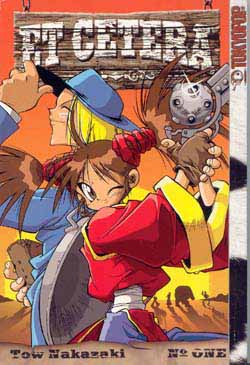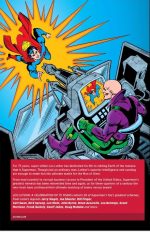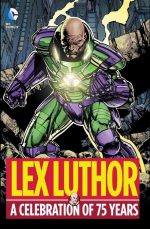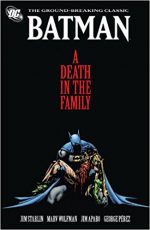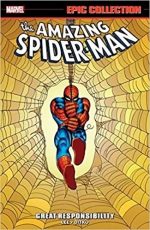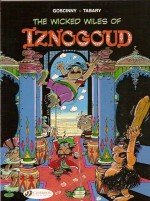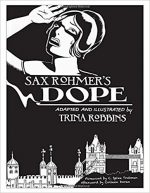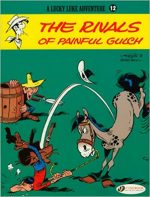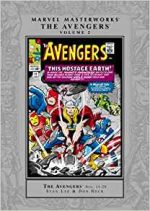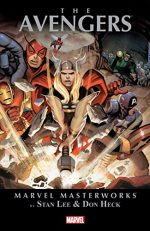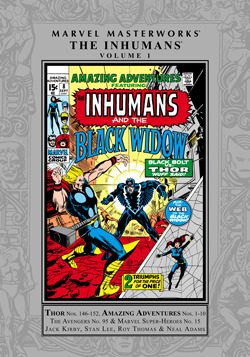
By Stan Lee, Jack Kirby, Archie Goodwin, Roy Thomas, Gerry Conway, Gene Colan, Neal Adams, Mike Sekowsky & various (Marvel)
ISBN: 978-0-7851-41419 (HC)Â Â Â Â Â Â Â Â Â Â Â Â Â Â Â Â 978-0-7851-4142-6 (TPB)
Debuting in 1965 and conceived as one more incredible lost civilisation during Stan Lee & Jack Kirby’s most fertile and productive creative period, The Inhumans are a secretive race of phenomenally disparate beings genetically altered by aliens in Earth’s primordial pre-history.
They subsequently evolved into a technologically-advanced civilisation far ahead of emergent Homo Sapiens and isolated themselves from the world and barbarous dawn-age humans, first on an island and latterly in a hidden valley in the Himalayas, residing in a fabulous city named Attilan.
The mark of citizenship is immersion in the mutative Terrigen Mists which further enhance and transform individuals into radically unique and generally super-powered beings. The Inhumans are necessarily obsessed with genetic structure and heritage, worshipping the ruling Royal Family as the rationalist equivalent of mortal gods.
With a new TV series debuting to mixed reviews and reactions, it’s worth taking a look at how the hereditary outsiders first impacted the Marvel Universe and this tome (available in hardcover, trade paperback and digital editions) compiles their first solo-starring appearances from the Tales of the Uncanny Inhumans back-up series in Thor #146-153, a one-off yarn from Marvel Super-Heroes #15, their run in Amazing Adventures #1-10, plus a guest shot in Avengers #95, spanning the period November 1967 to January 1972. Also included are a trio of spoof features taken from Not Brand Echh #6 and 12 (February 1968 and February 1969).
Designed to delight all fanboy truth-seekers, the Introduction by Mark Evanier sets the ball rolling with candid and informative behind-the-scenes revelations detailing the true publishing agenda and “Secret Origin of the Inhumansâ€, before reintroducing the Royal Family of Attilan. Black Bolt, Medusa, Triton, Karnak, Gorgon, Crystal and the rest would soon become mainstays of the Marvel Universe.
The hidden race began their first solo feature in from Thor #146: a series of complete, 5-page vignettes detailing some of the tantalising backstory so effectively hinted at in previous appearances. ‘The Origin of… the Incomparable Inhumans’ (by Lee, Kirby & Joe Sinnott) plunges back to the dawn of civilisation where cavemen flee in fear from technologically advanced humans who live on an island named Attilan.
In that futuristic metropolis, wise King Randac finally makes a decision to test out his people’s latest discovery: genetically mutative Terrigen rays…
The saga expands a month later in ‘The Reason Why!’ as Earth’s duly-appointed Kree Sentry visits the island and reveals how his masters in ages past experimented on an isolated tribe of primitive humanoids. Now observing their progress, the menacing mechanoid learns that the Kree lab rats have fully taken control of their genetic destiny and must now be considered Inhuman…
Skipping ahead 25,000 years, ‘…And Finally: Black Bolt!’ then reveals how a baby’s first cries wreck the city and reveal the infant prince to be an Inhuman unlike any other… one cursed with an uncontrollable sonic vibration which builds to unstoppable catastrophic violence with every utterance…
Raised in isolation, the prince’s 19th birthday marks his release into the city and contact with the cousins he has only ever seen on video screens. Sadly, the occasion is co-opted by Bolt’s envious brother Maximus who tortures the royal heir to prove he cannot be trusted to maintain ‘Silence or Death!’
Thor #150 (March 1968) saw the start of a lengthier continued tale as ‘Triton’ leaves the hidden city to explore the greater human world, only to be captured by a film crew making an underwater monster movie. Allowing himself to be brought back to America, the wily manphibian escapes when the ship docks and becomes an ‘Inhuman at Large!’
The series concluded with Triton on the run and a fish out of water ‘While the City Shrieks!’ before returning to Attilan with a damning assessment of the Inhumans’ lesser cousins…
The first Inhuman introduced to the world was the menacing Madame Medusa in Fantastic Four #36: a female super-villain joining team’s antithesis the Frightful Four. This sinister squad comprised evil genius The Wizard, shapeshifting Sandman and gadget fiend The Trapster and their battles against Marvel’s first family led to the exposure of the hidden race and numerous clashes with humanity.
In 1967 a proposed Inhumans solo series was canned before completion, but the initial episode was retooled and published in the company’s try-out vehicle Marvel Super-Heroes. Written by Archie Goodwin and illustrated by Gene Colan & Vince Colletta, ‘Let the Silence Shatter!’ appeared in #15 (July 1968), revealing how the villainous quartet were temporarily reunited after the Wizard promises a method for control Black Bolt’s deadly sonic affliction in return for Medusa’s services. As usual, the double-dealing mastermind betrays his unwilling accomplice but again underestimates her abilities and intellect, resulting in another humiliating defeat…
A few years later, bi-monthly “split-book†Amazing Adventures launched with an August 1970 cover-date and the Inhumans sharing the pages with a new Black Widow series. The big news however was that Kirby was both writing and illustrating the ‘The Inhumans!’
Inked by Chic Stone, the first episode saw the Great Refuge targeted by atomic missiles apparently fired by the Inhumans’ greatest allies, prompting a retaliatory attack on the Baxter Building and pitting ‘Friend Against Friend!’ However, even as the battle raged Black Bolt was taking covert action against the true culprits…
Issue #3 sees the uncanny outcasts as ‘Pawns of the Mandarin’ when the devilish tyrant tricks the Royal Family into uncovering a mega-powerful ancient artefact, but he is ultimately unable to cope with their power and teamwork in the concluding chapter ‘With These Rings I Thee Kill!’…
AA #5 (March 1971) ushered in a radical change of tone and mood as the currently on-fire creative team of Roy Thomas & Neal Adams took over the strip after Kirby shockingly left Marvel for DC.
Inked by Tom Palmer, ‘His Brother’s Keeper’ sees Maximus finally employ a long-dormant power – mind-control – to erase Black Bolt’s memory and seize control of the Great Refuge.
The real problem however, is that at the moment the Mad One strikes, Black Bolt is in San Francisco on a secret mission. When the mind-wave hits, the stranger forgets everything and as a little boy offers assistance, ‘Hell on Earth!’ (inked by John Verpoorten) begins as a simple whisper shatters the docks and the vessels moored there…
As Triton, Gorgon, Karnak and Medusa flee the now utterly entranced Refuge in search of Black Bolt, ‘An Evening’s Wait for Death!’ finds little Joey and the still-bewildered Bolt captured by a radical black activist determined to use the Inhuman’s shattering power to raze the city’s foul ghettoes. A tense confrontation in the streets with the police draws storm god Thor into the conflict during ‘An Hour for Thunder!’, but when the dust settles it seems Black Bolt is dead…
Gerry Conway, Mike Sekowsky & Bill Everett assumed the storytelling duties with # 9 as The Inhumans took over the entire book. Reaching America, the Royal Cousins’ search for their king is interrupted when they are targeted by a cult of mutants.
‘…And the Madness of Magneto!’ reveals Black Bolt in the clutches of the Master of Magnetism who needs the usurped king’s abilities to help him steal a new artificial element but ‘In His Hands… the World!’ (inked by Frank Giacoia) soon proves that with his memory restored nothing and no one can long make the mightiest Inhuman a slave…
The series abruptly ended there. Amazing Adventures #11 featured a new treatment of graduate X-Man Hank McCoy who rode the trend for monster heroes by accidentally transforming himself into a furry Beast. The Inhumans simply dropped out of sight until Thomas & Adams wove their dangling plot threads into the monumental epic unfolding from June 1971 to March 1972 in The Avengers #89-97.
At that time Thomas’ bold experiment was rightly considered the most ambitious saga in Marvel’s brief history: an astounding saga of tremendous scope which dumped Earth into a cosmic war the likes of which comics fans had never before seen. The Kree/Skrull War set the template for all multi-part crossovers and publishing events ever since…
It began when, in the distant Kree Empire, the ruling Supreme Intelligence is overthrown by his chief enforcer Ronan the Accuser. The rebellion results in humanity learning aliens hide among them, and public opinion turns against suerheroes for concealing the threat of repeated alien incursions…
A powerful allegory of the Anti-Communist Witch-hunts of the 1950s, the epic sees riots in American streets and a political demagogue capitalising on the crisis. Subpoenaed by the authorities, castigated by friends and public, the Avengers are ordered to disband.
Oddly omitted here, issue #94 entangles the Inhumans in the mix, disclosing that their advanced science and powers are the result of Kree genetic meddling in the depths of prehistory. With intergalactic war beginning, Black Bolt missing and his madly malign brother Maximus in charge, the Kree now come calling in their ancient markers…
Wrapping up the graphic wonderment here, ‘Something Inhuman This Way Comes…!’ (from Avengers #95, January 1972) coalesces many disparate story strands as aquatic adventurer Triton aids the Avengers against government-piloted Mandroids before beseeching the beleaguered heroes to help find his missing monarch and rescue his Inhuman brethren from the press-ganging Kree…
After so doing, the Avengers head into space to liberate their kidnapped comrades and save Earth from becoming collateral damage in the impending cosmos-shaking clash between Kree and Skrulls (a much-collected tale you’d be crazy to miss…).
Appended with creator biographies and House Ads for the Inhumans’ debut, the thrills and chills are topped off with three comedy vignettes. The first, from Not Brand Echh #6 (the “Big, Batty Love and Hisses issue!†of February 1968) reveals how ‘The Human Scorch Has to… Meet the Family!’: a snappy satire on romantic liaisons from Lee, Kirby & Tom Sutton, and is complimented by ‘Unhumans to Get Own Comic Book’ (Arnold Drake, Thomas & Sutton) and ‘My Search for True Love’ by Drake & Sutton: both from Not Brand Echh #12 (February 1969).
The first of these depicts how other artists might render the series – with contenders including faux icons bOb (Gnatman & Rotten) Krane, Chester (Dig Tracing) Ghoul and Charles (Good Ol’ Charlie…) Schlitz, whilst the second follows lovelorn Medoozy as she dumps her taciturn man and searches for fulfilment amongst popular musical and movie stars of the era…
These stories cemented the outsiders place in the ever-expanding Marvel universe and helped the company to overtake all its competitors. Although making little impact at the time they are still potent and innovative: as exciting and captivating now as they ever were. This is a must-have book for all fans of graphic narrative and followers of Marvel’s next cinematic star vehicle.
© 1967, 1968, 1970, 1971, 1972, 2017 Marvel Characters, Inc. All rights reserved.

